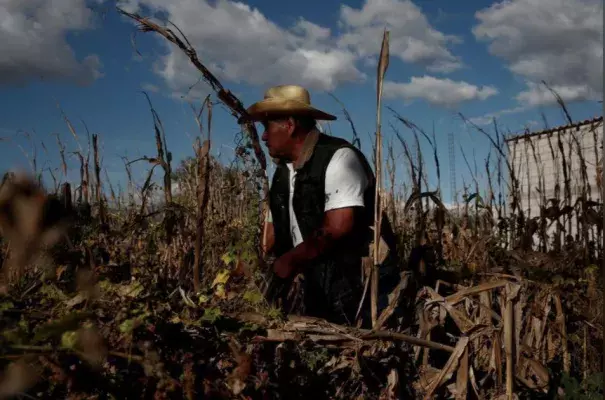In Mexico's cradle of corn, climate change leaves its mark

Climate Signals Summary: Warmer temperatures from climate change are drying out the land and soil, which can worsen drought and make it difficult to grow certain crops.
Article Excerpt: At least 9,000 years ago, humans began domesticating corn for the first time near Tehuacan, in the central Mexican state of Puebla, laying the foundation for permanent settlements in the Americas.
But in the past few years, more frequent and longer droughts have forced many farmers in the area to give up corn and other cereals in favor of alternatives requiring less water such as pistachio nuts or cactus.
Agricultural experts predict parts of Mexico will feel the effects of climate change more than many countries, not least because its location between two oceans and straddling the Tropic of Cancer expose it to weather volatility.
Sol Ortiz, director of the agriculture ministry’s climate change group noted that 75% of Mexico’s soil is already considered too dry to cultivate crops. In regions such as Tehuacan, temperatures may rise more than the global average.
...
Nationally, the area under corn cultivation declined 4% from 2015 to 7.4 million hectares last year. While factors leading farmers to switch crops are complex, in Tehuacan farmers and local officials describe fast-changing climate as a leading cause.
Mexico’s rainy season last year was the driest since 2011, which in turn was one of the driest on record, numbers from the country’s national water agency showed.
Climate change is expected to cause substantial declines in yields of corn globally, especially in the tropics, a 2018 study published in the U.S. Proceedings of the National Academy of Science concluded.
...
Garcia [a farmer in Tehuacan], who has 12 children, half of them working with him on the farm, recalls how one hectare in some years yielded as many as four tonnes (8,800 lbs) of corn In the past five years, he said, with luck it yielded 700 kg (1,543 lbs).
“The corn harvest has shrunk because in the months of June, July, August and September there was no rain,” said Garcia, 59, who uses ancestral farming techniques to grow corn, beans and pumpkin, an ancient system called a “milpa”.
“Our lives center on corn so what do we do without it?”
...
A 2016 study commissioned by the environment ministry and backed by the U.N. Development Program concluded climate change in Mexico will mean less rain, lower yields for basic grains such as corn, beans and wheat, as well as “unexpected effects on food security.”
...
In the north of Mexico, where large corn fields are irrigated, climate change may initially have little impact, studies show.
But in the south, where the oldest corn strains on earth are grown using traditional methods without irrigation, the changing rain patterns and temperatures are already being felt.
...
In an attempt to stop this trend, local authorities developed a bank of native corn seeds more resistant to pests and that need less water.
“We have to adapt to climate change, and these are the best varieties to recover food self-sufficiency,” Olmedo [director of rural development, agriculture and livestock in Tehuacan] said of the seeds.
Other government measures meant to help farmers adapt to and mitigate the effects of climate change include agricultural insurance, alternative crops and campaigns to reduce agricultural burning.
“It’s very difficult to reverse the tendency to increase CO2 (carbon dioxide) in the atmosphere,” said the agricultural ministry’s Ortiz. “That’s why we’re prioritizing adaptation.”
Related Content



